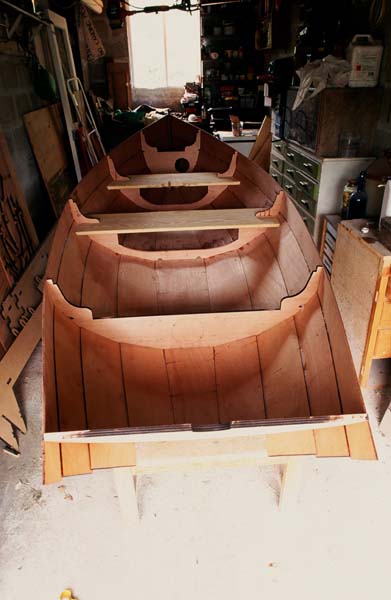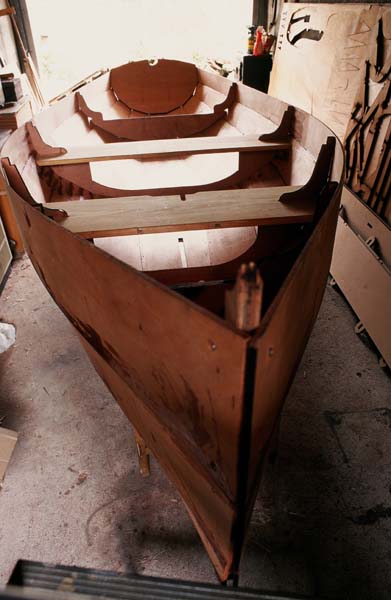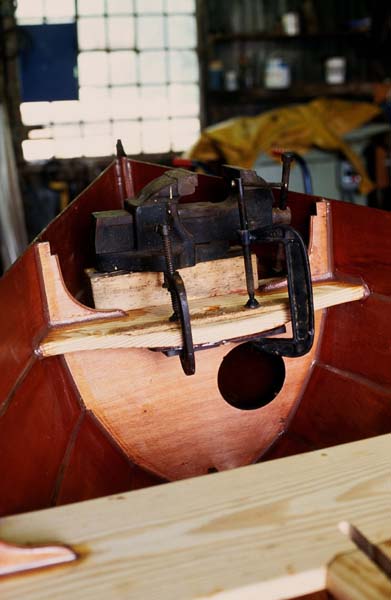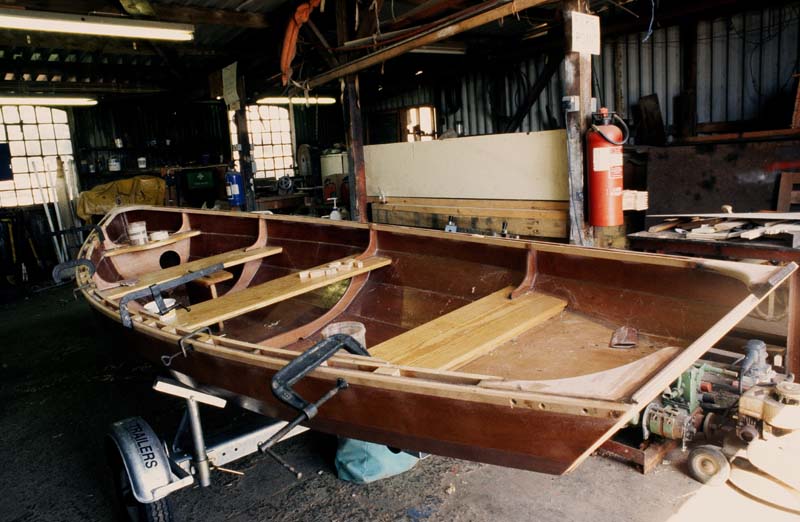Free plans to build your own epoxy-ply Western Skiff are available to download for amateur builders anywhere in the world. Nic Compton reports
When Nigel Irens designed the Western Skiff 22 years ago, boatbuilding as a hobby was enjoying a modest but significant revival in the UK.
Designers such as Iain Oughtred, Selway Fisher and Andrew Wolstenholme were developing expanding portfolios of plans for amateur construction, and a highly successful amateur boatbuilding competition (ABBA) was established, which is still going to this day.
Not content with just creating a dinghy for amateur boatbuilders, however, Nigel Irens, the designer of record-breaking multihulls such as B&Q, ENZA and Cable & Wireless decided that kit boats would be the logical next step forward.
Scroll to the bottom of article to download your own set of free plans today
Browse the complete set of eight articles in this series online
‘There’s more than a whiff in the air that kit building is in for a revival,’ he wrote. ‘Partly because, as in the post-war years, people are again looking for a way to get afloat without mortgaging their soul, and partly because there’s some new technology about that makes the whole idea more accessible to those who cannot claim to be master builders.’
The technology he was referring to was of course the new interface of CAD programmes and CNC cutters, which had by then been developed to a high level by mainstream manufacturers and was now ‘filtering down at the right price to ordinary mortals in cottage industries like boatbuilding’.

Designer Nigel Irens sails the prototype Western Skiff in 1998
The boatbuilding revolution has indeed progressed as Nigel predicted, and most of the boat plans offered by Oughtred, Fisher, Wolstenholme and others are now available in kit form through the likes of Jordan Boats and Fyne Boats.
What’s perhaps surprising is that those ‘kits’ are increasingly used by professional boatbuilders who appreciate the saving in their time, even if they already have the skills to build the boats without the help of a CNC cutter.
The Western Skiff
The design Nigel came up with all those years ago was a slender 14ft clinker plywood dinghy, with an upright stem and elegantly raked transom.
Although primarily a rowing boat, it was fitted with a modest lug rig (just 61sq ft/5.7sq m), complete with daggerboard and rudder.
In fact, the sweeping tiller (in two sizes: a long one for sailing and a short one for rowing) was one of the defining characteristics of the designs.
There was no provision for an outboard, and the transom was deliberately raked at such an angle to make it very difficult to fit one – although I eventually found a way around this!
Much of the detailed drawing work for the boat was done by up-and-coming young designer Ed Burnett, who was working for Nigel at the time.
Ed, who died in 2015, went on to design a string of highly regarded ‘contemporary traditional’ yachts, including the Queen’s ‘rowing barge’ Gloriana, which led the Queen’s Diamond Jubilee pageant on the Thames.
The Western Skiff was and still is the only dinghy designed by Nigel and is typically uncompromising, designed to be efficient on the water (or ‘slippery’ as Nigel would have it) rather than merely functional.


It was an idealistic rather than a pragmatic design, and quite different to any other boat on the market.
The boat was very much aimed at the amateur builder and the kit made in such a way as ‘to ensure that the average person can assemble a boat to a high standard with no more than handyman skills and some common sense.’
The plank joints, for example, were made up of long fingers, designed to maximize the glueing areas, which were slotted together in batches before being popped out of the sheets of ply.
This not only speeded up the process but also ensured the planks were lined up correctly. Likewise, the traditional bevel (or ‘land’) where one plank is jointed to the next was disposed of.
Instead, the angle between the planks was filled with epoxy, creating a series of incredibly strong and foolproof joints which also helped to stiffen the boat fore and aft.
The first Western Skiff was built by Anton Fitzpatrick of the Devon Dinghy Workshop during the winter of 1996-97, and three more were built as ‘guinea pigs’ soon after to test the kit and the instructions.
I was one of those ‘guinea pigs’ and built my skiff over a period of about four months – starting in my mother-in-law’s garage near Falmouth, Cornwall and finishing in my local rowing club in Lewes, East Sussex.
I was editor of Classic Boat at the time and was keen to increase the practical content of the magazine, so the Western Skiff kit became one of my pet projects – as well as the first and only boat I’ve built from scratch.
The commercial side of the kit gradually faded, as we all moved on to other things, but I kept my skiff – briefly called Hara (‘joy’ in Greek) and then Sally (my mother’s name) but mostly referred to simply as ‘the skiff’.
Indeed, while I’ve owned a succession of bigger boats – from a 36ft wooden yacht to a 22ft fibreglass dayboat (also designed by Nigel) – the skiff has remained a loyal companion, and I’ve never been tempted to sell her.

Nic on ‘the skiff’ which he refurbished in 2015
Living in Lewes in East Sussex, I rowed the boat regularly up and down the River Ouse, and I also had some great sails down as far as Newhaven, shooting bridges on the way, and then out to sea along Seaford Beach.
On one memorable occasion, a non-sailing friend came with me and, halfway down the Ouse, produced a flask and some china teacups and proceeded to pour us both a cup of tea as we careered down the valley (past the point where Virginia Woolf drowned herself) with the outgoing tide and a following breeze.
After years without a boat, it was thrilling to feel personally reconnected to the sea.
But my skiff really came into its own nearly 20 years after I originally built her, when my family and I moved to Devon in 2015.
Living a stone’s throw from the River Dart, the skiff gave us immediate access to the large and beautiful estuary – first under oar and then, after I fitted an outboard well as part of a major refurbishment of the boat under motor too (see the downloadable plans and instructions for more details on my outboard well design).
Interestingly, despite Nigel’s original reluctance to accommodate an outboard in his design, he was supremely relaxed about my conversion, and there’s no doubt the outboard has allowed us as a family to explore much further afield than was possible without it.

Under sail off Brighton
It was another year or so before I got around to refitting the rig, but I’ve had some great sails since then, both on my own in a fresh breeze, when I kept up tack for tack with a club Wayfarer, and with the family on board in lighter weather.
One notable afternoon I sailed with my son off nearby Galmpton, with a seal shadowing us for several minutes, before the rest of the family (dog included) climbed on board and we drifted home on a zephyr, the whole river bathed in gold by the evening sun.
At that moment, I wouldn’t have wanted to be anywhere else or on any other boat.
Supply and demand
Over the years, the skiff has attracted a lot of favourable comments and Nigel has received repeated requests for plans to build the design.
There’s even a forum thread entitled ‘Nigel Irens’ Western Skiff, need drawings, plans, anything!’ where someone called Scott Church confesses that he and a friend built several skiffs in Key West by scaling up the 8in cardboard cutout model which was given away with the Classic Boat magazine when we first launched the project.
“The boat was a huge hit, gorgeous and fast,” he says, before begging readers to send him a contact for the plans.

The simple clinker ply construction. Credit: Nic Compton
A lively conversation ensues with Ed Burnett discussing the merits of copyright, as well as the compromises needed to design a boat that rows well and yet still sails tolerably well too.
Until now, however, the answer to demands for plans has been a straight ‘no’.
The original drawings were specifically intended to be fed into a CNC cutter to produce parts for the kit and it was no simple matter to convert them into a set of construction plans.
Nigel didn’t have the time to do that, and I didn’t have the technology or the knowhow. So the drawings stayed buried in a computer, and the idea of relaunching the design remained just an idea.
It was the response to my skiff restoration article in PBO June 2018 that provided the impetus to get the idea going again, and this time we found a willing partner in the shape of Jack Gifford, a former GL Watson draughtsman who had recently set up shop on his own in Falmouth.
Jack agreed to turn the drawings into a set of PDF files, complete with full-size templates for many of the parts, which could be sent out to aspiring amateur builders.
Nigel generously suggested making the plans available free of charge for personal use only, in the spirit of ‘open source’ software, which Jack willingly agreed to.
PBO has also agreed to distribute the plans free of charge. The only thing we ask is for you to make a voluntary donation to the fund set up in the memory of Ed Burnett (see justgiving.com/fundraising/bill-burnett1).
Anyone wanting to build the boats for profit, will need to contact Nigel directly (at nigelirens.com) to pay a royalty.

The addition of an outboard in a well has allowed the family to explore further afield. See PBO June 2018. Credit: Zennor Compton
Study plans
The Western Skiff was always conceived first as a rowing boat, second as a sail boat and not at all as a motor boat! For rowing, a long pair of oars is essential – the original kit came with a pair of 8ft oars, which seemed to do the job nicely.
With one person rowing the boat is a bit light, and some form of ballast up forward – in the form of bottles of water, rocks, an outboard or, in my case, a dog! – trims it up nicely. With two people rowing, she’ll need trimming down by the stern slightly.
The sail plan shown is the original configuration which, it should be noted, was not judged a success by the boat’s designer.
The challenge for new builders is to design an improved rig, keeping the rig strictly within a set sail area (the exact size is yet to be decided – but it will be smaller than the current set-up).
This can be based on any configuration and using any materials that take the builder’s fancy.
Rules are meant to be broken and, although the boat was not designed to carry an outboard, there are ways and means.
After 15 years, I eventually succumbed to the inevitable and fitted an outboard well on my skiff – and it performs extraordinarily well under motor with a very small outboard (the 3.5hp we have is excessive; 2.8hp would be ample).
Being so easily driven and yet impossible to plane, it would be a natural contender for an electric outboard, budget permitting.
Neither the plans nor the kit include the outboard conversion, which will vary greatly according to what outboard is chosen, but they will include a description of how I did mine.

Credit: Nic Compton
What you need to do next…
Over the next few months PBO will be following the construction of the first Jordan Western Skiff kit by PBO reader Jeremy Butler in Devon.
Browse the complete set of eight articles in this series online
Although Jeremy was a boatbuilder for a few years and is therefore familiar with the techniques needed for epoxy ply construction, he now works as an IT consultant and hasn’t messed with the ‘sticky stuff’ for quite a while.
You can see how he gets on in the next few issues of PBO – or you can build one yourself ‘in parallel’ by getting the free plans from the link below, or ordering a kit from Jordan Boats.
There is also now a Facebook group: www.facebook.com/groups/192870162139114/
It’s been a long time coming, but at last the Western Skiff is available again.
The motivation for this new initiative is simply to get a lot more of these wonderful boats on the water, giving pleasure to many more builders and owners.
If the project gives others even a fraction of the pleasure I’ve had out of my Western Skiff, it will have been worth the effort.
Pre-cut plywood kit

One of the pre-cut boards of the first MkII plywood kit delivered by Alec Jordan
Even with large-scale and full-size PDF drawings to work from, cutting the parts for a 14ft dinghy can be a daunting task.
To make the boat even more accessible to the amateur builder we teamed up with Alec Jordan of Jordan Boats to produce a MkII kit – as was originally intended.
Unlike the original kit – which comprised everything including the timber, epoxy, spars, sail and rigging (and was correspondingly priced) – Alec’s kit contains just the plywood elements, which has allowed him to keep the total price under £1,000, at £992, plus delivery, to be exact (there is a row-boat only version that comes without daggerboard and housing for £52 less).
This nevertheless includes 6¼ sheets of ply and 2½ sheets of MDF (for the jig and various patterns) – to give a total of nearly 70 parts and patterns, as well as a 28-page building manual.
This approach means the builder can source the remaining parts and materials according to their budget and inclination.
Some might like a simple, painted rowing boat, others might want a bright finished sailing version, with the corresponding difference in build time and cost.
Another area where the MkII skiff differs from the original is the sail plan.
Although I’ve sailed the boat quite happily for the past 22 years with the original lug rig on wooden spars, Nigel feels that the original design was overcanvassed and top-heavy – and indeed we have both capsized our respective boats.
The idea with the new design is to leave the sail plan ‘open’ within a set sail area, so builders can experiment with different rigs.
This might be a carbon fibre-sparred version of the original lug rig, or a completely new approach – Nigel is currently favouring using a windsurf rig, but it will be interesting to compare sail plans.
Alec Jordan – The kit maker

Alec Jordan
Alec Jordan – the founder of Jordan Boats – has the rare distinction of having learned to sail on the Kalahari Desert.
After spending most of his childhood in St Lucia, he trained in IT and got a job in Botswana where he made his first solo sailing foray in a Finn dinghy on Gaborone Dam, on the edge of the Kalahari Desert.
Back in the UK, he settled in Aberdeen where he built a Sprite dinghy from a kit supplied by Jack Chippendale, which gave him the boatbuilding bug.
After 20 years in IT, he took up boatbuilding and started producing kit boats in 2003 – first a stitch-and-tape canoe by Selway Fisher and then moving on to clinker ply boats, starting with Iain Oughtred’s Feather Pram.
He now sells kits for more than 130 designs, from historic replicas to pocket cruisers and other designs by luminaries such as Iain Oughtred, Andrew Wolstenholme, Selway Fisher and François Vivier.
The Oughtred-designed St Ayles skiff is his most successful boat, selling upwards of 240 kits to date. The Western Skiff is the latest addition to his range.
jordanboats.co.uk
Jack Gifford – The plans man

Jack Gifford. Credit: Emily Harris
Thanks to his boat-mad father, Jack Gifford grew up thinking it was quite normal to dig up 100-year-old boats from the mud and restore them, and from an early age became addicted to classic yachts.
He spent his teens working for Dragon-meister Peter Wilson in Aldeburgh, before studying naval architecture at Southampton Institute. He worked for several years at the offices of GL Watson, working on projects such as the motor yacht Malahne, for which he helped design a new tender.
In 2016, he set up his own office in Falmouth to provide a range of naval architectural services such as stability assessments, coding and 3D scanning – as well as new boat designs.
Recent projects include designing a new gaff and topmast for the Fife 15-Metre The Lady Anne, creating a new interior for a Nicholson 34, and designing five 26ft rowing boats for an Outward Bound organisation in the Lake District.
More info at jackgifford.co.uk
Nigel Irens – The designer

Renowned designer Nigel Irens
Nigel Irens’s lifelong fascination with efficient hull shapes originates from childhood holidays to Salcombe, when he first learned to sail.
He studied Boatyard Management at Southampton College and got his first major break in 1982: designing IT82 for Tony Bullimore, which won its class in the Round Britain Race, followed by Apricot four years later.
Around this time, he designed the 80ft catamaran Formule Tag, which set a new 24-hour record of 512 miles in 1984 with Mike Birch at the helm.
Ten years later, she was stretched by 12ft, renamed ENZA New Zealand, and set a new Jules Verne Trophy record with joint skippers Peter Blake and Robin Knox-Johnston.
A string of record-breaking multihulls followed, including Fleury Michon VIII and IX and Fujicolour II.
He was also active in the powerboat field, with his iLAN Voyager setting a new round-Britain powerboat record in 1988, and Cable & Wireless setting new round-the-world powerboat record in 1998.
He received wider recognition in 2005 after Ellen MacArthur sailed his B&Q Castorama to a new round-the-world single-handed record, and he was awarded Royal Designer for Industry (RDI).
Alongside this mainstream success, he found time to dabble in traditional boats, designing the 29ft lugger Roxane in 1994, followed by her little sister, the 22ft Romilly, and of course the Western Skiff in 1997.
Looking back on the boat he created 22 years earlier, he says: “When Ed Burnett and I set about drawing the Western Skiff, we had the pleasure of designing something that only had to look good and row well. A boat that rows well has, almost by definition, a narrow waterline, and that means that she won’t have much in the way of righting moment.
“The simple and sane conclusion is that this shouldn’t matter because she’s so easily driven that she’ll fly along under the tiniest of rigs. In hindsight I have to say that I think the design team may have got a bit carried away with the temptation to put a ‘pretty’ rig on her. So I think messing around with different shapes and sizes of sail plans for different sized people could and should be a lot of fun.
“By chance I ran into an Austrian gent at the Düsseldorf Boat Show, who had bought a skiff kit from me back in the late 1990s. In case there was any doubt about his story, he pulled from his phone, with all the flourish of a magician, a picture of he and his skiff yachting along on an Austrian lake.
“He seems to feel that his outrageously exotic (gaff) rig is just right for the boat. I say good for him – and good for anyone else who likes to mess about with boats, in whatever way takes their fancy.
“Incidentally, Jeremy and Adrie Burnett kindly passed on to me a fine model of the skiff that Ed built to check, in his fastidious way, that the parts fitted together as intended. He’d be happy to see the revival of the skiff.”
How to get free plans
How to turn free plans into plywood parts and templates
- A set of PDF plans (excluding the sail plan and outboard conversion) for personal use only is available free of charge, but please, please don’t forget a small donation to the Ed Burnett memorial fund: justgiving.com/fundraising/bill-burnett1
- The 39 pages of plans (size ‘A zero’) should be printed (black & white is fine; printing firms are available online).
-
Once printed, join together individual sheets by matching the corresponding numbers in each corner and aligning the target marks.
-
Affix the templates directly onto plywood sheets (2440mm x 1220mm / 8ft x 4ft), aligning the edges and you are ready to cut the parts. We estimate
- 4 1/2 sheets 6mm ply
- 1 sheet 9mm ply
- 1 sheet 15mm ply
- 1/4 sheet 12mm ply
- 2 sheets 12mm MDF
- Solid timber (eg. 1in Douglas Fir) for thwarts, etc
Instructions for free Western Skiff plans – click here to download
Overview pdf of Western Skiff plans (10 pages of A4) – click here to download
Full set of pdf plans of Western Skiff (39 pages of A0) – click here to download
Rig dimensions & sail plan – click here to download
Building an outboard well during skiff restoration in 2015, by Nic Compton
Browse the complete set of eight articles in this series online
Reference photos to aid builders
Here is a selection of photos from the 1997 full original kit build by Nic Compton. Let us know at pbo@ti-media.com if there are photos you absolutely must have, or we can commission diagrams to explain any parts of the instructions that are not clear!

The completed jig viewed from astern, mounted on trestles. Note the black-edged parts: the burn marks from the laser used to cut the original kit parts in the 1990s.

The free set of plans calls for two of the thwarts to be fitted to the building jig. The frames then slot into the thwarts. The Jordan Boats pre-cut kit suggests a different method of aligning the frames thanks to extra features on the building jig.



Drilling holes to fit the plastic cable ties. Less is more at this stage – too many ties force the planks into unnatural shapes.

The garboards and bottom panel fitted over the frames and two of the four thwarts. Note the ‘long notch’ in the garboard facing ‘downwards’ as the boat is orientated (ie. away from the bottom boards). And the centreboard slot is aligned with the slot cut in the forward thwart.


Fitting planks 2 & 3 after sheathing the bottom panel and garboards. Note the overlap at the apron and the plastic cable ties helping to shape the planks.







The very first completed boat by Anton Fitzpatrick (minus gunwales and inwales) at Devon Dinghy Workshop in 1997. Note the side buoyancy tanks fitted snugly between frames either side of the centreboard case.









The various ‘doubled’ plywood sections that need glueing together.
What you get with the pre-cut sections from Jordan Boats
- Alternatively the pre-cut sheets cost £992 plus delivery – this includes plywood parts and templates for timber thwarts, tiller, keel and trim. This will have its own, slightly amended instruction sheets
- A rowing-only version comes without daggerboard cheeks, daggerboard and mast step.
Delivery will cost from approx £190 for southern England to £250 for northern Scotland. - Updates and amendments will be posted at pbo.co.uk





